The birdwatcher or naturalist turned wildlife sound-recordist finds himself or herself completely absorbed by a new set of priorities and concerns. Admittedly, the time of the avian breeding season is a feature common to both camps, but this is probably about the only one. We sound-recordists are highly motivated to locate areas far away from human disturbance, in particular free from extraneous noise. In fact, this is one of the major factors governing the choosing of our destinations. Unfortunately, it is so easy to get this wrong. Nowhere is immune to sonic disturbance, be it in the form of traffic or aircraft roar, the noises of agricultural machinery, bird-scarers, the humming of milking machines, drones from boating and, rather unexpectedly, radar bleeps (which invariably sweep a 360º path every 20 seconds or so, and get into the recording chain electronically).
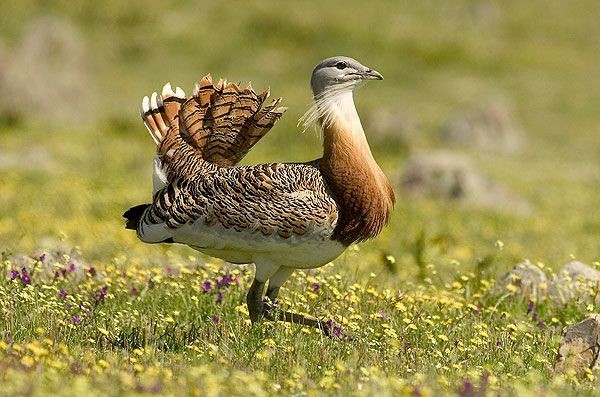
Great Bustard, Spain (Photo:
John Gardner)
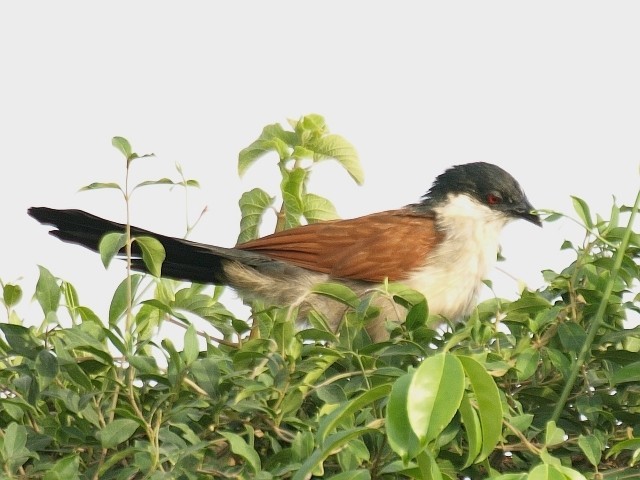
Senegal Coucal, Gambia (Photo:
Terry Gunby)
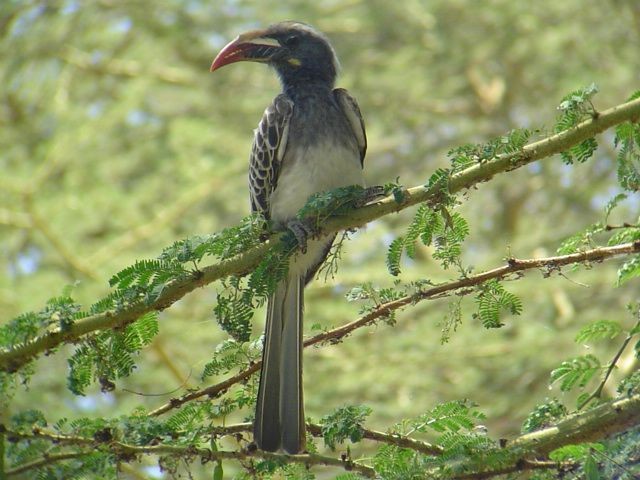
African Grey Hornbill, Kenya (Photo:
Shailesh Patel)
Between October 1996 and March 1998, I made three trips to The Gambia in search of sounds from Afro-tropical savannahs and woodlands, and the result was my audio CD of fifteen African sound pictures, perhaps not surprisingly entitled Gambian Soundscapes. To my knowledge, this was the first time that such a compilation of Gambian sounds had been attempted, as other publications encountered up until that date were clearly intended to serve for identification purposes only, usually being of poor acoustic quality and in monaural sound. By contrast, my intention was to convey something of the experience of actually being there in the searing heat and humidity of West Africa, and to this end I sought to render, in the highest sonic stereo quality that I and my kit of the day were capable of realising, the natural Gambian sounds in a series of immersive sound pictures. My Gambian Soundscapes includes the dry sounds of an afternoon of birds and cicadas vocalising in the primary gallery forest at Abuko; followed by "bouncing-ball" cadences from a Senegal Coucal (Centropus senegalensis), accompanied by several species of lugubriously chanting dove in savannah scrub on the coastal Tanji Nature Reserve. However, perhaps the atmospheres I made a day or two later at the Tendaba Camp, some 60 miles upriver, are the most evocative on the CD, for there I captured a party of natives returning from a day's work on the paddy-fields, and chatting away against piping from a pair of African Grey Hornbills (Tockus nasutus), constant "zitting" in the elephant grasses of Northern Red Bishops (Euplectes franciscanus), and flight calls from streams of Rose-ringed Parakeets (Psittacula krameri) flying under a luminous dusk across the marshlands to the roost. The next day found me dripping with sweat in the intense heat of a nearby savannah forest of stifling humidity, surrounded by droning insects, and the endless "clicking" of Grey-Backed Camaropteras (Cameroptera brachyura), with a soul-draining chorus of associated doves, occasional "choc-choc" calls from a Western Grey Plantain Eater (Crinifer piscata), and an intermittent "victor" call from a Klaas's Cuckoo (Chrysococcyx klaas) perching somewhere in the canopy beneath an unbearably hot midday sun. To this day I think that I succeeded in my aim of representing on a single CD the intense vibrancy of these tropical African soundscapes.
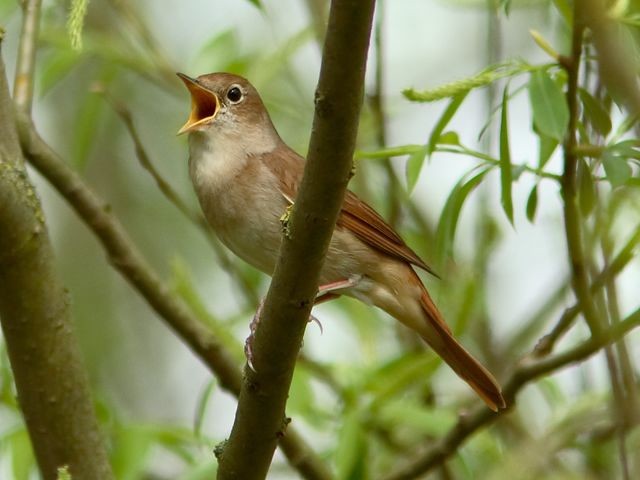
Nightingale, Paxton Pits NR, Cambridgeshire (Photo:
Ian Johnston)
Sound-recording expeditions to Hungary in 2003 and 2005 proved most productive for me and my fellow recordists. The fishponds at Halastó in the Hortobágy National Park on the Hungarian Great Plain gave us the night sounds of anurans (frogs and toads); jagged recitals from Sedge Warblers; dense reelings of Savi's and Grasshopper Warblers; and endless outpourings from a myriad Nightingales; all set against the powerful and far-carrying booming of Bitterns seemingly from every corner of the marshland. But for me it was the thin, rhythmic stanzas emanating from the vast stands of reeds that proved the greatest puzzle, so I just got on with making my recordings of these tantalising vocalisations, with the expectation of later identification. The structure of these "songs" reminded me of Thrush Nightingale, and I was not far wrong. The singers were Bluethroats, which share the Nightingale genus Luscinia, and the race was cyaneculus. Thus, White-Spotted Bluethroat (Luscinia svecicus cyaneculus), was captured in stereo sound, but never seen. Had it not been for the songs I wouldn't even have known they were there! Still, if one will insist on venturing forth in the middle of the night, what can one expect?
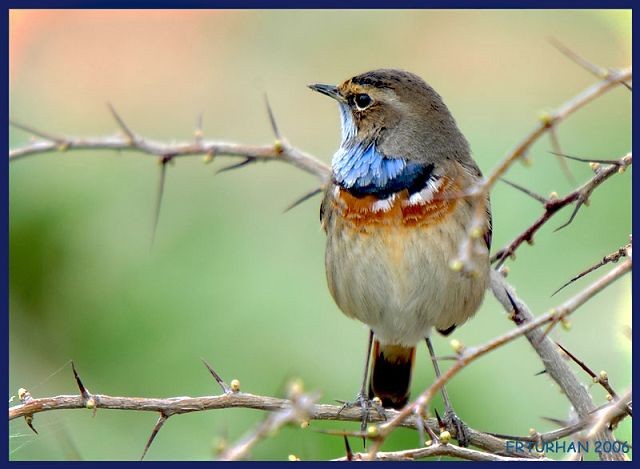
Bluethroat, Turkey (Asian) (Photo:
Mustafa Erturhan)
Two years later to the month, and again in rural Hungary, I pulled this same trick of "profiting without seeing". However, this time I was on the Bükk Hills, a wooded limestone region situated in the Northern Hills to the extreme north of the country. I had led a visually handicapped friend across-country to a small marsh surrounded by stands of Phragmites reeds, amongst which we were delighted to encounter a vociferous new arrival. Members of our group had listened out for this bird over the previous few nights, as we had known that a male had flown in to this reedbed at around this same date two years earlier. However, not a one of us had detected it on this latter trip, and I had chosen the nocturnal destination on the basis of an educated guess. We were very lucky, for we reached the spot some two hours earlier than the others. If we hadn't stolen this march, the singer's purity would have been compromised by the songs of the other species that constitute the dawn chorus, along with the racket caused by half-a-dozen eager and expectant sound recordists. (As luck would have it, my friend Les had made a mistake in reading his watch, and when he turned up at my door two hours early at 12.30am, I was too traumatised by lack of sleep to check the time.) Our migrant had freshly arrived and was singing with extreme vigour and imaginative inventiveness from the reed tops within a small area of the marsh close to my position. Needless to state that I was notably prompt in deploying my reflector so as to have the warbler's song spot-on the microphones. It was as though the singer was actually perching in the parabola itself! I hardly dared to breathe. My first-ever portrait of Marsh Warbler, and one which I think I might state with all modesty will take some bettering! Amongst European birds this warbler holds pride of place as the master mimic, for the analysis of sound recordings of this species has revealed elements of songs and calls of some 99 European and 133 African species. My singer – which again I never saw – sang its heart out endlessly! I made an extended recording at of the singing bird at around 02:45 hours European Time on the night of the 17th May 2005, and the location was the Upper Valley of Bükkszérc, within the Bükk National Park, eastern Hungary.
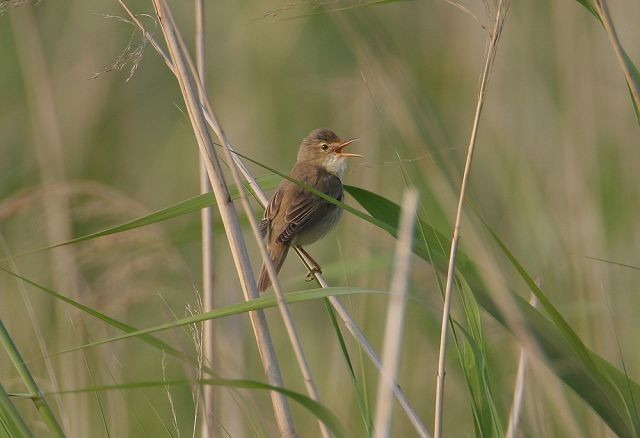
Marsh Warbler, Rainham Marshes RSPB, London, Greater (Photo:
Steve Arlow)
Should any wildlife sound recordist feel like improving on my Marsh Warbler, then they now know where they could try for a start!
We WSRS types are a determined, resourceful, imaginative, helpful, accomplished, inviting, friendly and indefatigable lot. We are a close and welcoming family, in fact. If you are at all captivated by the lure of wildlife sounds, then it is a must that you should check us out on our website, which is:

Ian Todd
The WSRS have an excellent website with details of their work, and how you can become a member.


